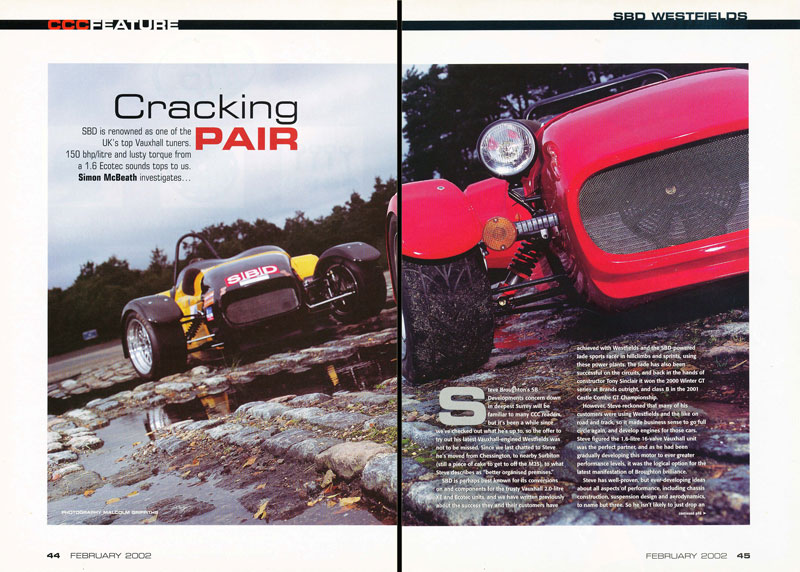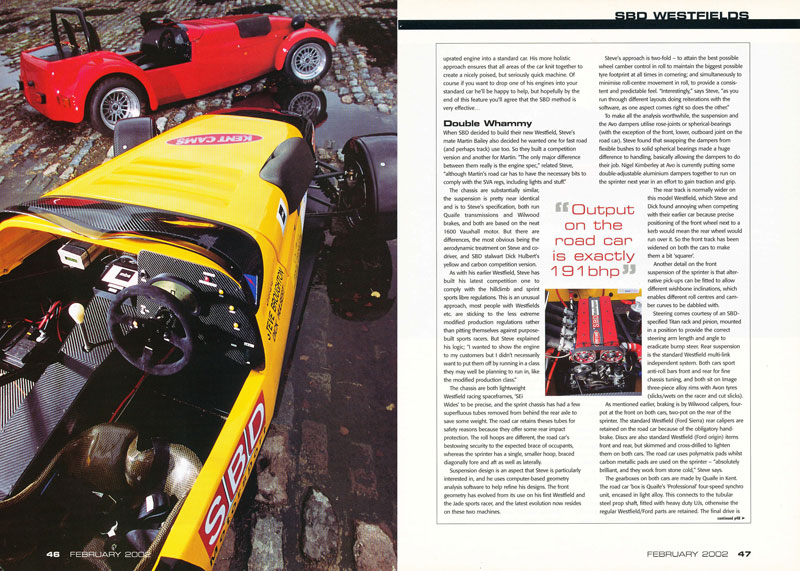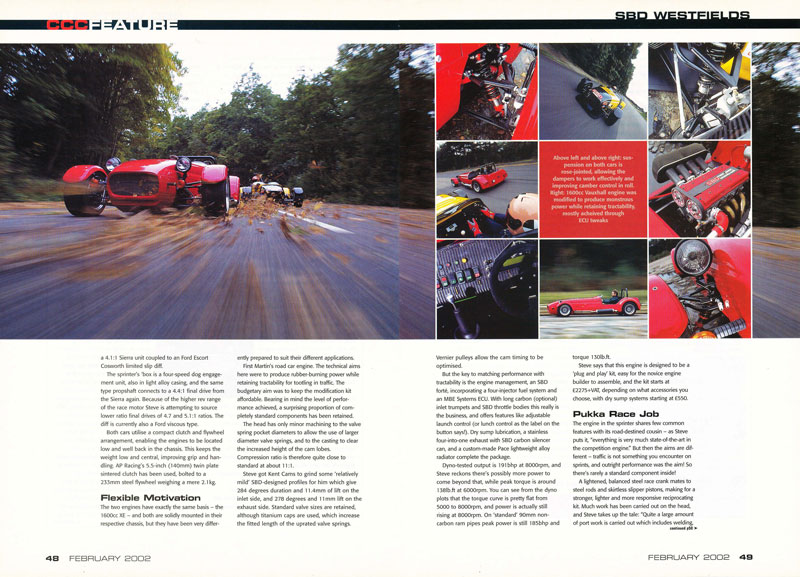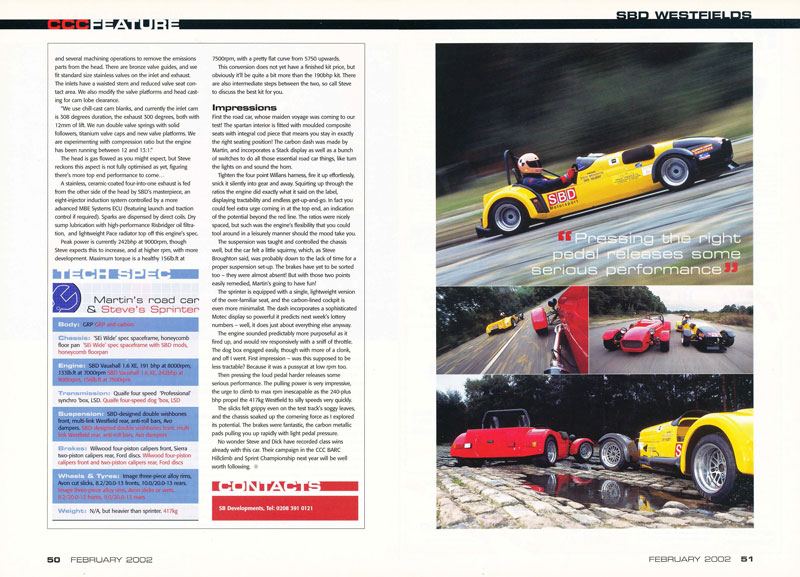CCC, February 2002 – SBD Westfield
SBD is reowned as one of the UK’s top Vauxhall tuners.
150bhp/litre and lusty torque from a 1.6 Ecotec sounds tops to us.
Simon McBeath investigates……
Steve Broughton’s SB Developments concern down in deepest Surrey will be familiar to may CCC readers, buts it’s been a while since we’ve checked out what he’s up to, so the offer to try out his latest Vauxhall-engined Westfields was not to be missed. Since we last chatted to Steve he’s moved from Chessington, to nearby Surbiton (still a piece of cake to get to off the M25), to what Steve describes as “better organised premises”.
SBD is perhaps best known for its conversions on and components for the trusty Vauxhall 2.0 litre XE and Ecotec units, and have have written previously about the success they and their customers have achieved with Westfield and the SBD-powered Jade sports racer in hillclimbs and sprints, using the power plants. The Jade has also been successful on the circuits, and back in the hands of constructor Tony Sinclair it won the 2000 Winter GT series at Brands outright, and class B in the 2001 Castle Combe GT Championship.
However, Steve reckoned that many of his customers were using Westfields and the like on road and track, so it made business sense to go full circle again, and develop engines for those cars. Steve figured the 1.6 litre 16 valve Vauxhall unit was the perfect partner, and as he had been gradually developing this motor to ever greater performance levels, it was the logical option for the latest manifestation of Broughton brilliance.
Steve has well-proven, but ever developing ideas about all aspects of performance, including chassis construction, suspension design and aerodynamics, to name but three. So he isn’t likely to just drop an uprated engine into a standard car. His more holistic approach ensures that all areas of the car knit together to create a nicely poised, but seriously quick machine. Of course if you want to drop one of his engines into your standard car he’ll be happy to help, but hopefully by the end of this feature you’ll agree that the SBD method is very effective.

Double Whammy
When SBD decided to build their new Westfield, Steve’s mate Martin Bailey also decided he wanted one for fast road (and perhaps track) use too. So they built a competition version and another for Martin. “The only major difference between them really is the engine spec” related Steve’ “although Martin’s road car has to have the necessary bits to comply with the SVA regs, including lights and stuff”.
The chassis are substantially similar, the suspension is pretty near identical and is to Steve’s specification, both run Quaife transmissions and Wilwood brakes, and both are based on the neat 1600 Vauxhall motor. But there are differences, the most obvious being the aerodynamic treatment on Steve and co-driver, and SBD stalwart Dick Hulbert’s yellow and carbon competition version.
As with his earlier Westfield, Steve has built his latest competition one to comply with hillclimb and sprint sports libre regulations. This is an unusual approach, most people with Westfields etc, are sticking to the less extreme modified production regulations rather that pitting themselves against purposed-built sports racers. But Steve explained his logic, “I wanted to show the engine to my customers but I didn’t necessarily want to put them off by running in a class they may well be planning to run in, like the modified production class”
The chassis are both lightweight Westfield racing spaceframes, ‘SEi Wides’ to be precise, and the sprint chassis has had a few superfluous tubes removed from behind the rear axle to save some weight. The road car retains these tubes for safety reasons because they offer some rear impact protection. The roll hoops are different, the road car’s bestowing security to the expected brace of occupants whereas the sprinter has a single, smaller hoop, braced diagonally fore and aft as well as laterally.
Suspension design is an aspect that Steve is particularly interested in, and he uses computer-based geometry analysis software to help refine his designs. The front geometry has evolved from its use on his first Westfield and the Jade sports racer, and the latest evolution now resides on these two machines. Steve’s approach is two-fold – to attain the best possible wheel camber control in roll to maintain the biggest possible tyre footprint at all times in cornering; and simultaneously to minimise roll-centre movement in roll, to provide a consistent and predictable feel. “Interestingly,” says Steve , “as you run through different layouts doing reiterations with the software, as one aspect comes right so does the other.
To make all the analysis worthwhile, the suspension and the Avo dampers utilise rose-joints or spherical-bearing (with the exception of the front, lower, outboard joint on the road car). Steve found that swapping the dampers from flexible bushes to solid spherical bearings made a huge difference to handling, basically allowing the dampers to do their job. Nigel Kimberley at Avo is currently putting some double-adjustable aluminium dampers together to run on the sprinter next year in an effort to gain traction and grip.
The rear track is normally wider on this model Westfield, which Steve and Dick found annoying when competing with their earlier car because precise positioning of the front wheel next to a kerb would mean the rear wheel would run over it. So the front track has been widened on both the cars to make them a bit ‘squarer’. Another detail on the front suspension of the sprinter is that alternative pick-ups can be fitted to allow different wishbone inclinations, which enables different roll centres and camber curves to be dabbled with.
Steering comes courtesy of an SBD-specified Titan rack and pinion, mounted in a position to provide the correct steering arm length and angle to eradicate bump steer. Rear suspension is the standard Westfield multi-link independent system. Both cars sport anti-roll bars front and rear for fine chassis tuning, and both sit on Image three-piece alloy rims with Avon tyres (slicks/wets on the racer and cut slicks).

As mentioned earlier, braking is by Wilwood calipers, four-pot at the front on both cars, two-pot on the rear of the sprinter. The standard Westfield (Ford Sierra) rear calipers are retained on the road car because of the obligatory hand-brake. Discs are also standard Westfield (Ford origin) items front and rear, but skimmed and cross-drilled to lighten them on both cars. The road car uses polymatrix pads whilst carbon metallic pads are used on the sprinter – “absolutely brilliant, and they work from stone cold,” Steve says.
The gearboxes on both cars are made by Quaife in Kent. The road car ‘box is Quaife’s ‘Professional’ four-speed synchro unit, encased in light alloy. This connects to the tubular steel prop shaft, fitted with heavy duty UJs, otherwise the regular Westfield/Ford parts are retained. The final drive is a 4.1:1 Sierra unit coupled to a Ford Escort Cosworth limited slip diff. The sprinter’s ‘box is a four-speed dog engagement unit, also in light alloy casing, and the same type propshaft connects to a 4.4:1 final drive from the Sierra again. Because of the higher rev range of the race motor Steve is attempting to source lower ratio final drives of 4.7 and 5.1:1 ratios. The diff is currently also a Ford viscous type.
Both cars utilise a compact clutch and flywheel arrangement, enabling the engines to be located low and well back in the chassis. This keeps the weight low and central, improving grip and handling. AP Racing’s 5.5-inch (140mm) twin plate sintered clutch has been used, bolted to a 233mm steel flywheel weighing a mere 2.1kg.
Flexible Motivation
The two engines have exactly the same basis – the 1600cc XE – and both are solidly mounted in their respective chassis, but they have been very differently prepared to suit their different applications.
First Martin’s road car engine. The technical aims here were to produce rubber-burning power while retained tractability for tootling in traffic. The budgetary aim was to keep the modification kit affordable. Bearing in mind the level of performance achieved, a surprising proportion of completely standard components has been retained. The head has only minor machining to the valve spring pocket diameters to allow the use of larger diameter valve springs, and to the casting to clear the increased height of the cam lobes. Compression ratio is therefore quite close to standard at about 11:1. Steve got Kent Cams to grind some ‘relatively mild’ SBD-designed profiles for him which give 284 degrees duration and 11.4mm of lift on the inlet side, and 278 degrees and 11mm lift on the exhaust side. Standard valves sizes are retained although titanium caps are used, which increase the fitted length of the uprated valve springs. Vernier pulleys allow the cam timing to be optimised.
But the key to matching performance with tractability is the engine management, an SBD forte, incorporating a four-injector fuel system and an MBE Systems ECU. With long carbon (optional) inlet trumpets and SBD throttle bodies this really is the business and offers features like adjustable launch control (or lunch control as the label on the button says!). Dry sump lubrication, a stainless four-into-one exhaust with SBD carbon silencer can and a custom-made Pace lightweight alloy radiator complete the package. Dyno-tested output is 191bhp at 8000rpm, and Steve reckons there’s possibly more power to come beyond that, while peak torque is around 138lb.ft at 6000rpm. You can see from the dyno plots that torque curve is pretty flat from 5000 to 8000rpm and power is actually still rising at 8000rpm. On ‘standard’ 90mm non-carbon ram pipes peak power is still 185bhp and torque 130lb.ft.
Steve says that this engine is designed to be a ‘plug and play’ kit, easy for the novice engine builder to assemble.

Pukka Race Job
The engine in the sprinter shares few common features with its road-destined cousin – as Steve puts it, “everything is very much state-of-the-art in the competition engine.” But then the aims are different – traffic is not something you encounter on sprints, and outright performance was the aim! So there’s rarely a standard component inside!
A lightened, balanced steel race crank mates to steel rods and skirtless slipper pistons, making for a stronger, lighter and more responsive reciprocating kit. Much work has been carried out on the head and Steve takes up the tale: “Quite a large amount of port work is carried out which includes welding and several machining operations to remove the emissions parts from the head. There are bronze valve guides, and we fit standard size stainless valves on the inlet and exhaust. The inlets have a waisted stem and reduced valve seat contact area. We also modify the valve platforms and head casting for cam lobe clearance. We used chill-cast cam blanks , and currently the inlet cam is 308 degrees duration, the exhaust 300 degrees, both with 12mm of lift. We run double valve springs with solid followers, titanium valve caps and new valve platforms. We are experimenting with compression ratio but the engine has been running between 12 and 13:1” The head gas flowed as you might expect, but Steve reckons this aspect is not fully optimised as yet, figuring there’s more top end performance to come….
A stainless, ceramic-coated four-into-one exhaust is fed from the other side of the head by SBD’s masterpiece, an eight-injector induction system controlled by a more advance MBE Systems ECU (featured launch and traction control if required). Sparks are dispensed by direct coils. Dry sump lubrication with high-performance Risbridger oil filtration, and lightweight Pace radiator top off this engine’s spec. Peak power is currently 242bhp at 9000rpm, though Steve expects this to increase, and at higher rpm, with more development. Maximum torque is a healthy 156lb.ft at 7500rpm, with a pretty flat curve from 5750 upwards. This conversion does not yet have a finished kit price, but obviously it’ll be quite a bit more that the 190bhp kit. There also intermediate steps between the two, so call Steve to discuss the best kit for you.
TECH SPEC
Martin’s road car & Steve’s sprinter
Body: GRP GRP and carbon
Chassis: ‘SEi Wide’ spec spaceframe , honeycomb floorpan ‘SEi Wide’ spec spaceframe with SBD mods, honeycomb floorpan
Engine: SBD Vauxhall 1.6 XE, 191bhp at 8000rpm 133lb.ft at 7000rpm SBD Vauxhall 1.6 XE 242bhp at 9000rpm, 156lb.ft at 7500rpm
Transmission: Quaife four speed ‘Professional’ synchro ‘box, LSD. Quaife four-speed dog ‘box, LSD
Suspension: SBD-designed double wishbones front, multi-link Westfield rear, anti-roll bars, Avo dampers. SBD-designed double wishbones front, multi-link Westfield rear, anti-roll bars, Avo dampers
Brakes: Wilwood four-piston calipers front, Sierra two-pistons calipers rear, Ford discs. Wilwood four-piston calipers front and two-pistons calipers read, Ford discs
Wheels & Tyres: Image three-piece alloy rims, Avon cust slicks, 8.2/20.0-13 fronts, 10.0/20.0-13 rears Image three-piece alloy rims, Avon slicks or wets 8.2/20.0-13 fronts, 9.0/20.0-13 rears
Weight: N/A, but heavier than sprinter. 417kg

Impressions
First the road car, whose maiden voyage was coming to our test! The spartan interior is fitted with moulded composite seats with integral cod piece which means you stay in exactly the right seating position! The carbon dash was made by Martin, and incorporates a Stack display as well as bunch of switches to do all those essential road car things, like turn the lights on and sound the horn.
Tighten the four point Willans harness, fire it up effortlessly, snick it silently into gear and away. Squirting up through the ratios the engine did exactly what it said on the label, displaying tractability and endless get-up-and-go. In fact you could feel extra urge coming in at the top end, an indication of the potential beyond the red line. The ratios were nicely spaced, but such was the engine’s flexibility that you could toot around in a leisurely manner should the mood take you. The suspension was taught and controlled the chassis well, but the car felt a little squirmy, which, as Steve Broughton said , was probably down to the lack of time for a proper suspension set-up. The brakes have yet to be sorted too- they almost absent! But with those two points easily remedied, Martin’s going to have some fun.
The sprinter is equipped with a single, lightweight version of the over-familiar seat and the carbon-lined cockpit is even more minimalist. The dash incorporates a sophisticated Motec display so powerful it predicts next week’s lottery numbers- well it does just about everything else anyway.
The engine sounded predictably more purposeful as it fired up, and would rev responsively with a sniff of throttle. The dog box engaged easily, though with more of a clonk and off I went. First impression – was this supposed to be less tractable? Because it was a pussycat at low rpm too. Then pressing the loud pedal harder releases some serious performance. The pulling power is very impressive, the urge to climb to max rpm inescapable as the 240-plus bhp propel the 417kg Westfield to silly speeds very quickly.
The slicks felt grippy even on the test track’s soggy leaves, and the chassis soaked up the cornering force as I explored its potential. The brakes were fantastic, the carbon metallic pads pulling you up rapidly with light pedal pressure.
No wonder Steve and Dick have recorded class wins already with this car. Their campaign in the CCC BARC Hillclimb and Sprint Championship next year will be well worth following.
Reproduced with permission of CCC Magazine
